Introductory Handbook
for Sailing Boats
HOW TO RIG A LIDO

Start with the paperwork. Sign up on the sailboat signout sheet in the clubhouse.
Select a hull from the yard, checking carefully for Do Not Sail signs or missing parts. Be sure the hull has an anchor and a bailer.
If the boat wasn't left propped up in the yard with all the hull drains unscrewed, you have to drain it. Just lean all your weight on the transom, and the hull will tip back, with the metal bar of the trailer preventing damage to the hull.
Collect paddle, rudder, and tiller from the container and put them in the hull. If the sling isn't already at the hoist, collect it from the container as well. Get the mainsail and jib from the sail locker next to the clubhouse, and pick up some lifejackets (a.k.a. personal flotation devices, or PFD's) from the container while you're at it.
Using the Hoist
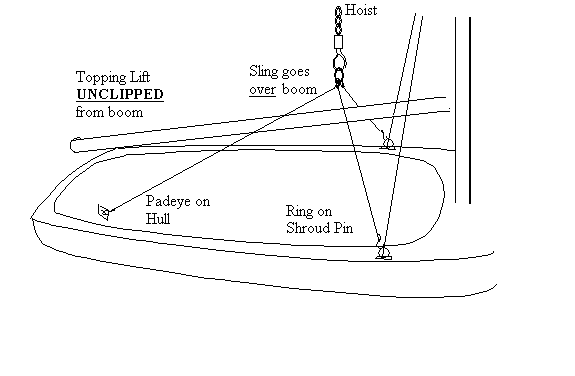
Attach the sling to the hoist and the boat. Move the trailer to position the hook over the boom. Make sure the sling is over the boom, not under it. Make sure the boat is untied from the trailer.
Before hoisting the hull over the water, drape the bow painter around the starboard shroud where you can get it easily. Hoist the hull as high as it will go. DON'T LET ANYONE GET UNDER THE BOAT WHEN IT'S HOISTED Lower the boat onto the water and tie it to the dock under the hoist temporarily (use a triple half hitch in a bight).
Centerboard Controls
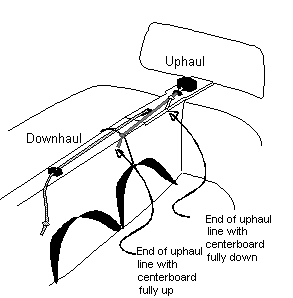 Lower the centerboard by uncleating the uphaul line and pulling the downhaul (stretchy cord). You should feel the centerboard go down, and see the uphaul line disappearing
into the hull.
Lower the centerboard by uncleating the uphaul line and pulling the downhaul (stretchy cord). You should feel the centerboard go down, and see the uphaul line disappearing
into the hull.
The position of the end of the uphaul line is the only indication of the centerboard position. When the centerboard is retracted all the way up into the hull, the end of the uphaul line comes about halfway down the centerboard case, as shown in the figure above.
When the centerboard is fully down, the stopper knot in the uphaul line is about an inch from the black plastic fairlead that holds the uphaul line.
If the tide is low, raise the centerboard halfway up by releasing the downhaul line and pulling the uphaul line until its end is about midway between the board up and board down positions. Then pull on the downhaul line to hold the centerboard down.
Never release the uphaul line when the downhaul line is under tension. The stretched downhaul line will catapult the centerboard forward with a clunk, slamming it into the hull and splintering the fiberglass.
Boom Topping Lift
The topping lift for the boom should be clipped into one of the holes on the end of the boom as soon as possible when the boat is in the water, and left on while sailing. It helps prevent damage to the hull from the boom falling onto the fiberglass.
Rudder, Tiller, and Paddle
Put the rudder on the boat, after first swinging the rudder lock aside. Then swing the rudder lock back so that it prevents the rudder from accidentally being lifted off.
Using a bowline knot, tie the rudder's safety line to the boat. Pass it under the traveler line (the rope with the pulley on it for the mainsheets) and tie it to the padeye on the hull where the sling attaches. Put the tiller onto the rudder and make sure the button inside the tiller engages the hole on top of the rudder.
Slip the flat end of the paddle under one of the elastic lines which hold up the forward hiking straps and which cross over the centerboard trunk. Slide the paddle forward to rest the flat end inside the anchor box.
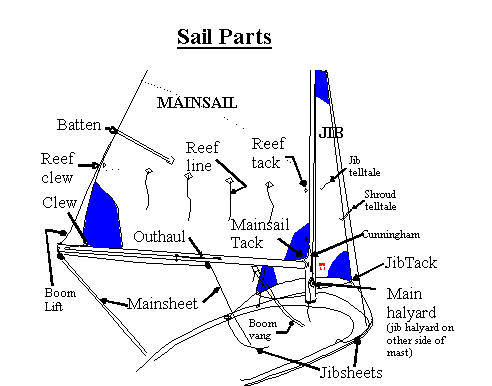
Sails
Attach the mainsail's tack to the boom, using the levered rod in the boom end fitting.
Attach the mainsail's clew to the snap shackle on the outhaul line at the end of boom. You may need to loosen the outhaul.
Undo the cleat hitch holding the main halyard snug. Make sure the mainsail isn't twisted. Thread the metal slide and rope on the mainsail into the groove in the mast. Detach the main halyard's shackle from its slip knot, and check that the halyard isn't twisted overhead. Attach the shackle to the mainsail.
The jib should have a hook on its tack that slips into a hole in the metal forestay fitting at the bow. Attach the hanks (brass snaps) on the jib to the forestay, starting at the tack and working upwards. Pass the jib sheets outside the shrouds and through the jib sheet fairleads on the hull. Tie figure eight stopper knots in the ends of the jib sheets. After checking that the jib halyard isn't twisted, attach its shackle to the jib.
Before you raise the sails, be sure the boat is pointed into the wind (in an east wind, this means take the hull to the west side of the dock first). Don't raise the jib until you're ready to go, and lower it as soon as you dock. In winds over 5 knots at the dock, leave the mainsail down, too.
Raise the mainsail first. Make sure the mainsheet is uncleated. As you raise the mainsail, feed the rope on the front edge of the sail into the groove in the mast. If it's hard to raise all the way, loosen the outhaul and boom vang. Tie the halyard with a cleat hitch. Wrap the ears of the cleat with the halyard until the cleat ears are buried, so the jib sheets won't catch on them.
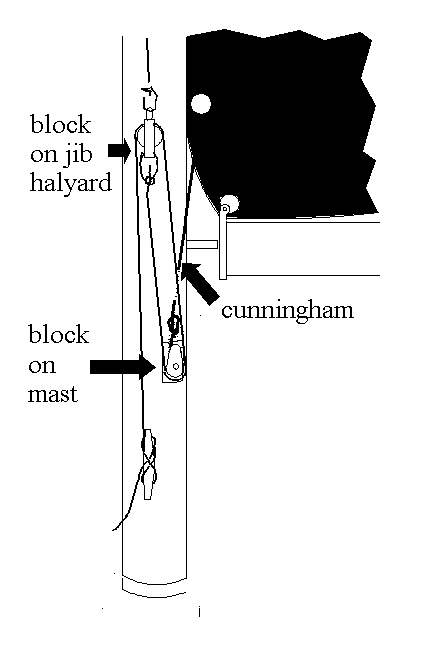
Pass the cunningham up through its hole in the mainsail and down through its jam cleat. Tighten the cunningham and outhaul to adjust the mainsail's shape; pull harder in high winds to make a flat sail. Tighten the boom vang to keep the boom from rising above horizontal.
Raise the jib. Before cleating the halyard, reach up to the block tied into the halyard. Pull the loop of line from the block on the halyard and pass it around the block on the mast. Then tighten the jib halyard hard until the jib's luff wire is very tightly stretched; the forestay should go slack. Wrap the ears of the cleat with the halyard.
Reefing
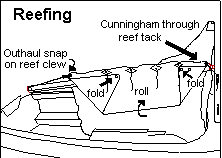
Reef the mainsail if the wind speed is high and/or the crew's weight is low. Reefing is easiest with the mainsail lowered. Loosen the outhaul completely and reattach its snap to the reef clew. Take the mainsail's tack off the boom and rethread the cunningham through the reef tack. Fold the clew and tack over in triangular folds, then roll up the foot of the sail. Tie it up with the reef lines using reef knots. The reef lines should not go around the boom.
When you raise the reefed mainsail, pull the halyard and outhaul tight to flatten the sail for high winds. To unreef, lower the sail and detach the reef clew and tack, undo the reef knots, and reattach the clew, tack, and cunningham before raising the sail again.
Don't forget your water wings! Everyone should have a life jacket on. People who can't swim get the bulky Mae West style life jackets; children get the smaller size jackets available in swimmers' and non-swimmers' styles.
And don't forget the paperwork. Sign that boat out.
Taking Over A Pre-Rigged Boat
If you take over a boat someone else rigged, check their job carefully. Make sure the safety equipment (anchor, paddle, bailers) is on board and properly stowed so you won't lose it in a capsize.
Derigging
If someone else wants your boat when you're done, be sure to sign it in and make sure they sign it out. Otherwise you're responsible for derigging it.
Lower the sails and detach them. Attach the halyard shackles to slip knots tied in the halyards, and cleat the halyards to keep them from banging against the mast. Carry the sails to the container area for folding, being very careful not to bend or break the battens in the mainsail.
Move the boat underneath the hoist and attach it with the sling. Bail out any water over 1" deep in the hull. Take the rudder and tiller off. Raise the centerboard and cleat its uphaul. Get the trailer under the hoist before you lift the hull.
Hoist the hull from the water. Swing the bow around the hoist so the mast and shrouds don't strike the hoist. Lower the hull onto the trailer and take off the sling from the hull.

Drain the hull before you put it away. Take out the tiller, rudder, and paddle, and any other parts that may slide around. First drain the cockpit, then unscrew the hull drains and drain the hull. Make a note in the log if there is more than a quart of water inside the hull.
Using the hose, rinse all the blocks on the hull and mast, and spray off the salt and mud from the hull.
Put the hull away in the yard with HULL DRAINS OUT AND TRAILER TILTED UP. Return the paddle, anchor, rudder, tiller, and sling to the container.
Folding Sails
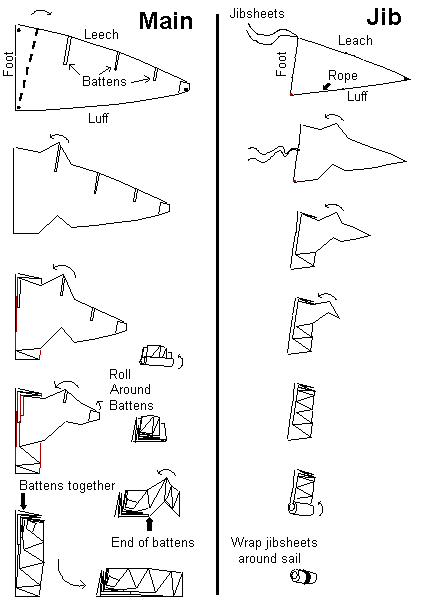
Fold the jib and the mainsail in accordion pleats. The mainsail battens should be kept bunched together.
After folding the mainsail lengthwise, fold it again crosswise to make a bundle the length of the battens, then roll the bundle around the battens to protect them.
After folding the jib lengthwise, roll it up and wrap the jib sheets around it.
Stow the sails away in the sail locker. Don't forget the paperwork. Sign the boat back in.





